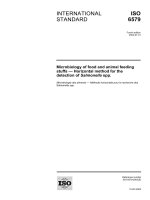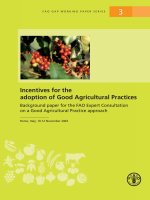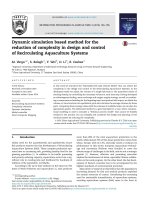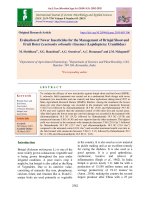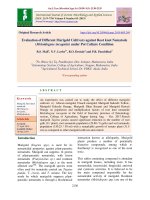Survey for the incidence of root-knot nematode (Meloidogyne incognita) in FCV tobacco growing soils of Karnataka
Bạn đang xem bản rút gọn của tài liệu. Xem và tải ngay bản đầy đủ của tài liệu tại đây (284.9 KB, 6 trang )
Int.J.Curr.Microbiol.App.Sci (2020) 9(8): 887-892
International Journal of Current Microbiology and Applied Sciences
ISSN: 2319-7706 Volume 9 Number 8 (2020)
Journal homepage:
Original Research Article
/>
Survey for the Incidence of Root-knot Nematode (Meloidogyne incognita) in FCV
Tobacco Growing Soils of Karnataka
B. N.. Ashwini1*, H. Ravindra2 and T. M. Soumya3
1
Department of Plant Pathology, 2AINRP (TOBACCO), ZAHRS, 3Department of Agronomy,
College of Agriculture, College of Agriculture Shivamogga, University of Agricultural and
Horticultural Sciences, Shivamogga, India
*Corresponding author
ABSTRACT
Keywords
Root-knot
Nematode
(Meloidogyne
incognita)
Article Info
Accepted:
10 July 2020
Available Online:
10 August 2020
An intensive roving survey was undertaken in major tobacco growing districts
of Karnataka viz., Mysuru, Hassan, Shivamogga and Davanagere to know the
extent of root-knot nematode infestation. Results revealed that the disease was
widespread in all the tobacco growing regions of Karnataka with an average
root-knot index of 2.90. Maximum root-knot incidence was noticed in Harave
village of Hunsur taluk, Mysuru district with nematode population of 756.00
J2/200 cc soil and 356.00 J2/5 g of root. Whereas, least incidence of root-knot
infestation was observed in Kattige village of Davanagere district, with
nematode population of 120.00 J2/200 cc soil and 105.00 J2/5 g of root.
Introduction
industries (Ravindra, 2007).
Tobacco (Nicotiana tabacum L.) is one of the
most economically significant crop in the
world. It is said to have been introduced into
India in the beginning of 17th century. The
plant belongs to the genus Nicotiana and to
solanaceae (nightshade) family (Gopalachari,
1984).Unlike in other crops, in tobacco, the
ultimate product is the leaf that is consumed
and leaf contains the principle alkaloid called
Nicotine. The oil obtained from tobacco is
gaining more importance as it is edible and
known to be good for heart patients and it is
also used as a pain killer and also in soap
Tobacco is grown in an area of 0.45 million
ha (0.27% of the net cultivated area)
producing 800 million kgs of tobacco leaf.
India stands second in production and export
of tobacco in the world after China and Brazil
respectively. Southern transition zone (STZ)
of Karnataka is ideally suited for growing
export quality of FCV tobacco. It is grown
mainly in parts of Shivamogga, Chikmagalur,
Davanagere, Hassan, Kodagu and Mysuru
districts. Karnataka produces FCV tobacco to
the tune of 98.72 million kgs from an area of
76,089 ha with an average yield ranging
887
Int.J.Curr.Microbiol.App.Sci (2020) 9(8): 887-892
between 1200-1300 kg/ha (Anon., 2017).
rubber band and labeled immediately.
Information about the locality, crop history,
etc., was also obtained along with the
samples. Samples of soil and roots were
placed in the refrigerator and analyzed on the
next day of collection. The nematode
populations from soil and root samples were
estimated.
In Karnataka, tobacco crop grown in light soil
provides ideal conditions for development and
perpetuation of pathogens. There are many
diseases caused by fungi, bacteria, viruses,
nematodes and root parasite, orobanche
affecting yield and quality of tobacco both in
the nurseries and main field (Ravindra, 2007).
Root-knot, a disease caused by root-knot
nematodes M. incognita and M. javanica is a
primary production constraint in tobacco. In
India, root-knot nematode, M. incognita, have
been estimated to cause yield loss upto 22 per
cent from field infestation and 50 per cent if
the infestation started in the seedbed
(Shepherd and Barker, 1990).
The galled root system was scored by using 0
to 5 disease rating scale given by Taylor and
Sasser (1978).
Grade
0
1
2
Root-Knot nematode continues to be the
major production threat both in the nursery
and main field since tobacco is cultivated as
monocrop in some parts of STZ. The genus,
Meloidogyne has several species and
information regarding different species is very
meager. Therefore, survey was conducted in
major tobacco-growing areas with varied soils
of Karnataka to identify and to determine the
intensity of root-knot nematode infestation.
3
4
5
Description
No galls
1-2
galls/root
system
3-10
galls/root
system
11- 30 galls/root
system
31-100 galls/root
system
>100
galls/root
system
Disease reaction
Immune
Resistance
Moderately
resistance
Moderately
susceptible
Susceptible
Highly
susceptible
Nematode population assessment
Extraction of nematodes from soil
From the collected samples, nematodes were
extracted by following Cobb’s sieving and
decanting technique (Cobb’s, 1918) followed
by Modified Baermann’s funnel method
(Whitehead and Hemming, 1965). Dilution
method was followed for counting of rootknot nematodes.
Materials and Methods
An intensive roving survey was undertaken
during Kharif2017 in major tobacco growing
districts of Karnataka viz., Mysuru, Hassan,
Shivamogga and Davanagere. From each
district, selected taluks, from each taluk four
villages and in each village three farmer fields
were surveyed.
After incubation of 24 hrs, the extracted J2
nematode population was made up to a known
volume (usually 100 ml) and the suspension
was bubbled through a pipette, out of which 5
ml was transferred to a Perspex counting dish.
The nematode numbers were counted by
using Tally counter under a stereo binocular
microscope. Nematode populations from this
were finally estimated for 200 cc soil.
Soil and root samples were collected from the
rhizosphere of the infected tobacco plants.
Samples from 6-7 spots were collected
randomly representing the whole field. From
this, composite samples, 200 cc of soil and 5
g of roots were used as working samples for
further studies. Each sample collected was
filled in a polythene bag and tied with a
888
Int.J.Curr.Microbiol.App.Sci (2020) 9(8): 887-892
Hunsur showed highest root-knot nematode
incidence with RKI of 4.30, whereas, it was
2.00 in Periyapatna. Nematode population
from the soil of different villages of Hunsur
taluk was compared, Harave village ranked
first (756.00 J2/200 cc soil), followed by
Hunsur (560.00 J2/200 cc soil), H.
Ramenahalli (540.00 J2/200 cc soil) and
Chilkunda (480.00 J2/200 cc soil). Whereas,
root nematode population was highest in
Harave (356.00 J2/5g of root) followed by H.
Ramenahalli (277.00 J2/5g of root), Hunsur
(232.00 J2/5g of root) and Chilkunda (137.00
J2/5g of root).
Estimation of nematode population from
root samples
Nematode populations in 5 g of roots were
estimated by root incubation method (Ayoub,
1977). Roots were gently washed with tap
water to get free of soil particles. Washed
roots were cut into small bits of 2.5 to 3.0 cm
and these were placed over tissue paper
spread on a wire gauge and mounted on a
Petri plate. Level of water was maintained in
Petri plate and left undisturbed for 24 hrs.
After 24hrs, the content of Petri plate was
emptied into a beaker, diluted to a suitable
volume and population counts were made
with the help of Fenwicks multi-chamber
counting slide and observed for nematodes by
using a stereo binocular microscope. Based on
requirement the suspension was diluted with
sterile water. Five aliquots were examined
from each sample and the average population
was calculated.
Among four villages of Periyapatna taluk,
Haptur showed the highest soil and root
nematode population (420.00 J2/200 cc soil
and 240.00 J2/5g of root) followed by Hunse
koppa (350.00 J2/200 cc soil and 188.00 J2/5g
of root), Hitne hebbagilu (260.00 J2/200 cc
soil and 180.00 J2/5g of root) and Billalahalli
(180.00 J2/200 cc soil and 120.00 J2/5g of
root).
Results and Discussion
An intensive roving survey was undertaken in
major tobacco growing districts of Karnataka
viz., Mysuru, Hassan, Shivamogga and
Davanagere to know the extent of root-knot
nematode infestation. Results presented in
Table 1 revealed that the disease was
widespread in all the tobacco growing regions
of Karnataka with an average root-knot index
of 2.90. Maximum root-knot incidence was
noticed in Harave village of Hunsur taluk,
Mysuru district with nematode population of
756.00 J2/200 cc soil and 356.00 J2/5 g of
root. Whereas, least incidence of root-knot
infestation was observed in Kattige village of
Davanagere
district,
with
nematode
population of 120.00 J2/200 cc soil and
105.00 J2/5 g of root.
Ramanathpura, Keragodu, Lakkuru and Lakki
kuppe are the villages that were surveyed in
Arkalgud taluk of Hassan district. Among
these villages, Lakki kuppe showed the
highest soil nematode population (650.00
J2/200 cc soil) and Lakkuru showed highest
root nematode population (320.00 J2/5 g of
root), whereas, least soil and root nematode
population was noticed in Ramanathpura
(360.00 J2/200 cc soil and 103.00 J2/5g of
root) respectively.
An average nematode population of 240.00 J2/
200 cc soil and 153.75 J2/5 g of root was
recorded in Davanagere district. In this
district, FCV tobacco was majorly grown in
Honnali taluk. Among different villages of
Honnali taluk, Kenchikoppa had nematode
population of 320.00 J2/200 cc soil and
210.00 J2/5g of root with highest root-knot
nematode infestation which was followed by
In Mysuru district, FCV tobacco was grown
in different villages of Hunsur and
Periyapatna taluks. Among these two taluks,
889
Int.J.Curr.Microbiol.App.Sci (2020) 9(8): 887-892
Soraturu (270.00 J2/200 cc soil and 110.00
J2/5 g of root), Jeenahalli (250.00 J2/200 cc
soil and 190.00 J2/5g of root) and Kattige
(120.00 J2/200 cc soil and 105.00 J2/5g of
root) respectively.
average root-knot index of Shivamogga taluk
was 3.54.
Taluk wise comparison of root-knot incidence
showed that Hunsur had the highest incidence
with root-knot index of 4.30, followed by
Arkalgud (3.66), Shivamogga (3.54),
Periyapatna (2.00) and least root-knot index
was recorded in Honnali (1.96). However,
comparison of district mean of root-knot
index revealed that root-knot incidence was
maximum
in
Hassan
followed
by
Shivamogga, Mysuru and Davanagere
respectively (Fig. 1).
Similarly, in Shivamogga district, Navile
showed the highest soil and root nematode
population (590.00 J2/200 cc soil and 298.00
J2/5g of root), followed by Kunchenahalli
(488.00 J2/200 cc soil and 187.00 J2/5g of
root), Mallapura (470.00 J2/200 cc soil and
223.00 J2/5g of root) and Hunasodu (444.00
J2/200 cc soil and 202.00 J2/5g of root). The
Table.1 Survey for the incidence of root-knot nematode in FCV tobacco growing soils of
Karnataka during 2017-18
District
Taluk
Mysuru
Hunsur
Periyapatna
District mean
Hassan
Arkalgud
Village
Hunsur
Harave
Chilkunda
H. Ramenahalli
Hitnehebbagilu
Billalahalli
Haptur
Hunse koppa
Ramanathpura
Keragodu
Lakkuru
Lakki kuppe
District mean
Davanagere
Honnali
Kattige
Jeenahalli
Kenchikoppa
Soraturu
District mean
Shivamogga
Shivamogga
Hunasodu
Kunchenahalli
Mallapura
Navile
District mean
890
Nematode
population/
200 cc soil
560.00
756.00
480.00
540.00
260.00
180.00
420.00
350.00
443.25
360.00
470.00
585.00
650.00
516.25
120.00
250.00
320.00
270.00
240.00
444.00
488.00
470.00
590.00
498.00
Nematode
population/
5 g root
232.00
356.00
137.00
277.00
180.00
120.00
240.00
188.00
216.25
108.00
224.00
320.00
295.00
236.70
105.00
190.00
210.00
110.00
153.75
202.00
187.00
223.00
298.00
227.5
RKI
(0-5)
4.30
2.00
3.15
3.66
3.66
1.96
1.96
3.54
3.54
Int.J.Curr.Microbiol.App.Sci (2020) 9(8): 887-892
Plate.1 Root-knot nematode infected FCV tobacco plant and roots
Fig.1 District mean of root-knot index
4.30
3.54
The present investigations are in conformity
with the findings of a survey conducted by
Hussaini and Krishnamurthy (2002) who
observed that there was no healthy tobacco
crop found in Hunsur, Periyapatna and
Ramanathpura areas. They also noticed that
the root-knot nematode disease was
widespread in tobacco growing areas of
Karnataka with an average incidence of 81.9
per cent. Further, these results are also in line
with survey conducted by Ravindra (2007a)
under AINRP (T) in Karnataka, they noticed
average RKI of 1.00 to 5.00 in different
clusters of Honnali, Shivamogga and Tarikere
and found that in all clusters of Hassan and
Mysuru districts root-knot incidences were
high and average RKI ranged from 2.00 to
5.00. Further, similar results were observed
by Ravindra, 2012.
In conclusion, the survey showed that the
disease varied from region to region with soil
type, cultivar used and cropping pattern
practiced. Monocroping has favoured the
build up of nematode population in soil
leading to heavy infestation and lose to the
crop yield. Due to resistance breaking ability
of nematodes it is very much needed to go for
cultivation different cultivars during every
growing season to avoid severity of root-knot
nematode damage.
Acknowledgement
This research was supported by University of
Agricultural and Horticultural Sciences
funded Directorate of Research, Senior
Research Project. I thank my major advisor
Dr. H. Ravindra, Professor and Chief
891
Int.J.Curr.Microbiol.App.Sci (2020) 9(8): 887-892
Scientist, AINRP (TOBACCO), ZAHRS,
College of Agriculture, University of
Agricultural and Horticultural sciences,
Shivamogga who provided insight and
expertise that greatly assisted the research.
knot nematode of tobacco. Ph.D.
Thesis,
Kuvempu
University,
Shivamogga.
Ravindra, H. 2012. Survey for the occurrence
ofroot-knot nematode in Karnataka
light soils (KLS). Quinquennial review
report (2008-13), AINRP (T).
Shepherd, J.A. and Barker, A.K. 1990.
Nematode parasites of tobacco. pp.
493-517 In:Plant-parasitic nematodes
in
subtropical
and
tropical
agriculture. M. Luc, R. A. Sikora, and
J. Bridge, (eds.) Wallingford: CAB
International.
Taylor, A. L. and Sasser, J. N., 1978, Biology,
identification and control of root-knot
nematodes (Meloidogyne species).
IMP. North Caroline States Univ.,
Graphics, pp. 111.
Whitehead, A. G. and Hemming, J. R., 1965,
A comparison of some quantitative
methods of extracting small vermiform
nematodes from soil. Ann. Appl. Biol.,
55: 25-38.
References
Anonymous. 2017. Annual report for 201617, Tobacco board, India.
Cobb, N.A. 1918. Estimating the nema
population of the soil. Agricultural
Technology Circular-1, pp. 48. Bureau
of plant industry, U.S.D.A. California,
USA.
Gopalachari, N.C. 1984. Tobacco published
by Indian Council of Agricultural
Research, New Delhi.
Hussaini, S.S. and Krishnamurthy, G.V.G.
2002. Occurrence and distribution of
root-knot species of FCV tobacco in
Karnataka. Indian J. Nematol., 32(1):
20-22.
Ravindra, H. 2007. Ecofriendly approaches
for the integrated management of rootHow to cite this article:
Ashwini, B. N., H. Ravindra and Soumya, T. M. 2020. Survey for the Incidence of Root-knot
Nematode (Meloidogyne incognita) in FCV Tobacco Growing Soils of Karnataka.
Int.J.Curr.Microbiol.App.Sci. 9(08): 887-892. doi: />
892
